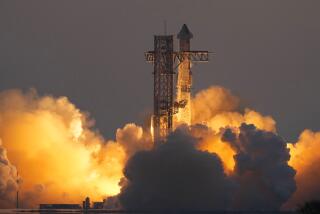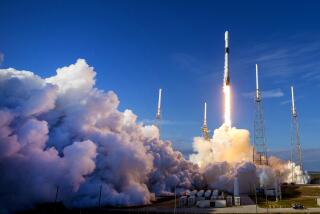Boosters Had to Be Destroyed When One Headed for Towns
- Share via
KENNEDY SPACE CENTER, Fla. — A booster rocket launched with the space shuttle Challenger was looping out of control toward the populous Florida coast when the Air Force destroyed it, space officials revealed Wednesday.
The decision to blow up the rocket and its twin was made by the Air Force, according to the National Aeronautics and Space Administration.
While this may have averted a second disaster on Tuesday, it also meant that whatever valuable clues to the explosion that the boosters might have held were shattered into a sea-bound flurry of debris.
The solid-fuel boosters were designed to assist the shuttle into orbit. Like all U.S. space vehicles, they were equipped with a “destruction package” of detonators and fuses, Air Force Lt. Col. Robert W. Nicholson said.
Still Burning
Less than two minutes after the shuttle was launched, it and the external fuel tank exploded in a fiery ball. The two solid-fuel booster rockets, still burning, went their own ways.
Both were monitored by a range safety officer at the Cape Canaveral Air Force Base. When one appeared to have been veering toward the Florida coast, rather than out to sea, both were blown up with the push of a red button, Nicholson said. That sent a radio signal triggering the explosions.
“It’s our responsibility to protect the land mass,” he added. “The boosters were out of control and needed to be destroyed.”
Center’s Director
Announcement that one of Challenger’s two boosters had veered dangerously toward the coast was made during a Wednesday morning press conference here by Dr. Richard G. Smith, director of the John F. Kennedy Space Center.
“There was indications that the trajectory of one of the solids was headed in towards a populated area and (the Air Force) took actions to destroy it and that was appropriate,” Smith said.
But neither he nor Nicholson would say exactly toward which city the rocket was heading.
More to Read
Sign up for Essential California
The most important California stories and recommendations in your inbox every morning.
You may occasionally receive promotional content from the Los Angeles Times.








